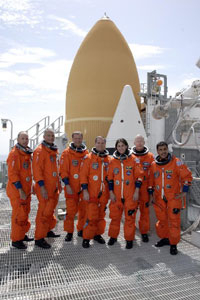As a child, John “Danny” Olivas (1993 MSME) used to wonder what lay beyond the stars he peered at through a telescope on the roof of his El Paso, Texas home.
These nights he spent with his father looking through the lens of the star gazing tool would fuel a fascination with space that years later would take him closer to an answer as a NASA astronaut. Now a veteran of one space flight, the 43-year-old father of five is finishing preparations for a second trip propelling him nearer to the bright stars he looked at as a kid.
Discovery’s STS-128 mission, carrying Olivas, is slated to launch from NASA’s Florida-based Kennedy Space Center Aug. 28 bound for the International Space Station. During the 13-day mission—the fourth shuttle mission of 2009—the University of Houston Cullen College of Engineering alumnus will lead three spacewalks.
Each of the space walks—mostly centered on replacing an ammonia tank used to move excess heat from inside the space station to radiators outside—are expected to last nearly six and a half hours. The first alongside fellow Discovery crew member Nicole Stott, who will take the position of Tim Kopra on the station, will prepare for the replacement of the empty tank.
“The first work site we’re going to is the port one truss area, which is along the truss backbone of the space station,” Olivas is cited as saying in the transcript of his recent preflight interview on NASA’s Web site. “On there is the ammonia tank assembly, the ATA, and we will be essentially disconnecting that ATA and removing it from the truss segment and then handing it off to a robotic arm.”
This is in addition, he said, to retrieving a large pallet of science experiments from outside the Columbus Laboratory on the station and stowing them in Discovery’s cargo bay for their return to Earth.
Two days later, Olivas will partner with Christer Fuglesang from the European Space Agency to remove the new ammonia tank from the shuttle’s payload bay and install it outside the station. The two will also remove the empty tank from the robotic arm—later positioning and preparing it for the trip back home.
A veteran of the Atlantis mission STS-117 where he logged more than 14 Extravehicular Activity (EVA) hours, Olivas admits he and Fuglesang will have their hands full on this trip out into space.
According to Olivas, at more 1,800 pounds, the ammonia tank assembly is the largest orbital replacement unit that’s been handled by an EVA crew member.
“That’s a lot of mass,” he said. “We’ll have one (tank) attached to the robotic arm, but then we’re also going to put an EVA crew member on that same robotic arm holding the new ammonia tank assembly. So it’s going to be a handful not only for the robotic arm, but, you know, Christer Fuglesang is going to be doing a lot of working out in the gym to be able to wrestle with that 1,800 pound mass.”
Olivas and Guglesang will carry out several smaller tasks in the third spacewalk. This includes replacing a device to help the station determine its position relative to Earth as well as attach cables to the station in preparation for the arrival of the Tranquility node—planned for February 2010.
Beyond the spacewalks, the mission will bring some 15,200 pounds of cargo on the Multi-Purpose Logistics Module, Leonardo. The pressurized module will be temporarily installed in the station on day four to deliver science and storage racks allowing crew from the station to conduct experiments on materials such as metals, glasses and ceramics. The cargo will assist them in studying how the materials mix and solidify outside the confines of Earth’s gravity. Also on the module, will be a freezer to store research samples, a new sleeping compartment and the COLBERT treadmill.
STS-128 is the 30th mission dedicated to construction of the International Space Station. Following its launch, only six flights remain before the shuttles retire in 2010 to make way for a new manned space craft intended to fly to the moon and then go on to Mars.
